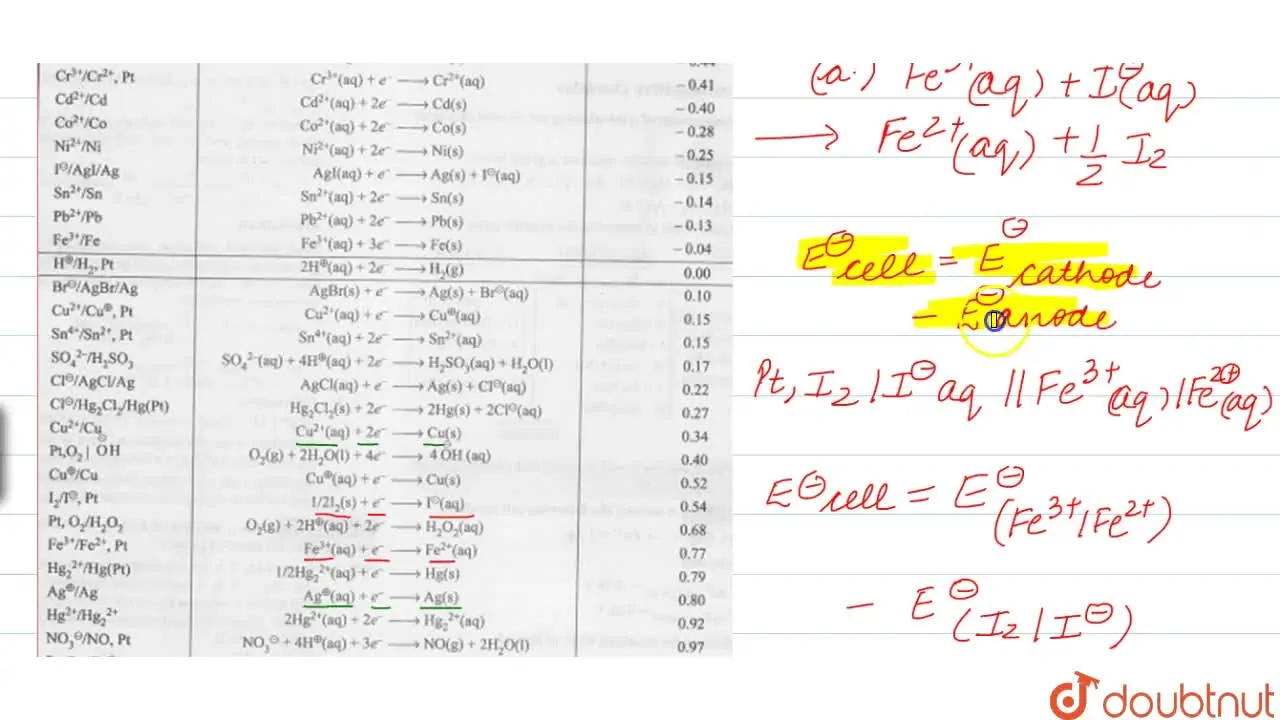Using the standard electrode potentials given in Table, predict if the reaction between the following is feasible:
a.Fe3+(aq) and Ic−(aq)
b. Ag⊕(aq) and Cu(s)
c. Fe3+(aq) and Brc−(aq)
d. Ag(s) and Fe3+(aq)
e.Br2(aq) and Fe2+(aq).
(a) The possible reaction between Fe3+(aq) and I−(aq) is
2Fe3+(aq)+2I−(aq)→2Fe2+(aq)+I2(s)
The above redox reaction can be split into the following two half reaction one involving oxidation and the other redcution wiritng electrode potential for each half rection from
overall reaction 2Fe3+(aq)+2I−(aq)→2Fe2++I2(s)
since the EMF for the above reaction Ag+ (aq) and Cu (s) is
Cu(s)+2Ag+(aq)→Cu2+(aq)+2ag(s)
The above redox reaction can be split into the following two half reaction writing electrode potential for each half reaction form we have
oxidation Cu(s)→Cu2(aq)+2e−,E∘=−0.34V
Reduction Ag+(aq)+E−→Ag(s)×2,E∘=+0.80V
overall reaction Cu(s)+2Ag+(aq)→Cu2+(aq)+2(s),E∘=+0.46V
since the EMF of the above reaction comes out to be postive therefore the above reaction is feasible (c ) suppose the reaction between Fe3+(aq)→Cuaq+2Ag(s),E∘=+0.46V
since the EMF of the above reaction comes oiut to be postive therefore to the following equatin
Cu(s)+2Fe3+(a)→3Cu(aq)+2Fe2+(aq)
the above reaction can be split into the following two half reaction wirting elecrode potential for each half reaction from we have
oxidation Cu(s)→Cu2+(aq)+2e−,E∘=−0.34V
Reduction Fe3+(aq)+E−→Fe2+(aq)×2,E2=+0.77V
overall reaction Cu(s)+2Fe3+(aq)→Cu2++2Fe2+(aq),E∘=+0.43V
since the EMF of the reaction is postive therefore the above reaction is feasible
alternatively if the raction between 1 Fe3+ (aQ) and Cu (s) occurs according to the followng equation
The EMF of the reaction comes out to be -ve -0.36 V(-0.34 V -0.034 V) and hence this rection is not feasible
(d) suppose the reaction between Ag(s) and Fe3+ (Aq) occurs accoding to the following eqation
The above reaction can be split into the following two half rection writing electrode potential for each half reaction from we have
oxidation Ag(s)→Ag+(aq)+e−,E∘=−0.80V
Reduction Fe3+(aq)+E−→Fe2+(aq),E∘=+0.77V
since the EMF of the reaction is negative therefore the above reaction is not feasible
Alternatively the rection between Ag (s) and Fe3+ (aQ) may occur according to the following equation
3Ag(s)+Fe3+(aq)→3Ag+(aq)+Fe(s)
on similar lines we can calcualte the EMF of this reaction comes to be even followng equation
Br2(aq)+2Fe2+(aq)→2Br−(aq)+2Fe2+(aq)
the above reaction can be split in to the followng two half rection writing electrode potential for each half reaction from the we have
oxidation Fe2+(aq)→Fe3+(aq)+e−×2,E∘=−0.77V
Reduction : Br2(aq)+2e−→Br−→2Br−(aq),E∘=+1.09V
overall reaction 2Fe2+(aq)+Br2(aq)→2Fe3+(aq)+2Br−(aq)'E∘=+0.32V since the EMF for the above reaction is positive therefore this reaction is feasible
Related Playlists
- BOOK - PRADEEPCHAPTER - REDOX REACTIONS EXERCISE - NCERT(EXEMPLAR PROBLEMS WITH ANSERS HINTS AND SOLUTION-I)11videos
REDOX REACTIONS
- BOOK - PRADEEPCHAPTER - REDOX REACTIONS EXERCISE - NCERT(EXEMPLAR PROBLEMS WITH ANSERS HINTS AND SOLUTION-II)5videos
REDOX REACTIONS
- BOOK - PRADEEPCHAPTER - REDOX REACTIONS EXERCISE - NCERT (QUESTIONS AND EXERCISES WITH ANSWERS)10videos
REDOX REACTIONS
- BOOK - PRADEEPCHAPTER - POLYMERSEXERCISE - IMPORTANT Questions (For Board Examination)27videos
POLYMERS
- BOOK - PRADEEPCHAPTER - SOLUTIONSEXERCISE - IMPORTANT QUESTIONS FOR BOARD EXAMINATION31videos
SOLUTIONS
Similar Questions
Using the standard electrode potentials given is the Table 1 predict if the reaction between the following is feasible :
(a) Fe3+(aq)andI−(aq)
(b) Ag+(aq)andCu(s)
(c) Fe3+(aq)andCu(s)
(d) Ag(s)andFe3+(aq)
(e) Br2(aq)andFe2+(aq) .View SolutionUsing the standard electrode potentials, predict if the reaction between the following is feasible :
(a) Fe3+(aq) and I−(aq), (b) Ag+(aq) and Cu(s)
(iii) Fe3+(aq) and Br− (aq), (d) Ag (s) and Fe3+ (aq)
( c) Br2(aq) and Fe2+ (aq).
Given standard electrode potentials:
E∘1/2,I2=0.541V,E∘Cu2+,Cu=0.34V
E∘1/2,Br2,Br−=1.09V,E∘Ag+/Ag=0.80V
E∘Fe3+,Fe2+=0.77VView SolutionUsing the standard electrode potentials given in the table predict if the reaction between the following feasible.
(a)Fe3+(aq)andI−(aq)
(b)Ag+(aq)andCu(s)
(c)Fe3+(aq)andCu(s)
Ag(s)andFe3+(aq)
(Br2)(aq)andFe2+(aq)
(d)Ag(s)andFe3+(aq)
(e)Br2(aq)andfe2+(aq)View SolutionUsing the standard electrode potentials given in Table, predict if the reaction between the following is feasible:
a.Fe3+(aq) and Ic−(aq)
b. Ag⊕(aq) and Cu(s)
c. Fe3+(aq) and Brc−(aq)
d. Ag(s) and Fe3+(aq)
e.Br2(aq) and Fe2+(aq).View SolutionUsing the standard electrode potentials given in Table, predict if the reaction between the following is feasible:
a.Fe3+(aq) and Ic−(aq)
b. Ag⊕(aq) and Cu(s)
c. Fe3+(aq) and Brc−(aq)
d. Ag(s) and Fe3+(aq)
e.Br2(aq) and Fe2+(aq).View SolutionUsing the standard electrode potentials given in Table, predict if the reaction between the following is feasible:
a.Fe3+(aq) and Ic−(aq)
b. Ag⊕(aq) and Cu(s)
c. Fe3+(aq) and Brc−(aq)
d. Ag(s) and Fe3+(aq)
e.Br2(aq) and Fe2+(aq).View SolutionUsing standard electrode potentials, predict the reaction, if any, that ocurs between Fe3+(aq)andI−(aq)
E∘Fe3+(aq)/Fe2+(aq)=0.77V,E∘I2/2I−(aq)=0.54VView SolutionWhat is ‘A’ in the following reaction?
2Fe3+(aq)+Sn2+(aq)→2Fe2+(aq)+AView SolutionIn the following reaction, which is the species being oxidised ? 2Fe3+(aq)+2I−(aq)→I2(aq)+2Fe2+(aq)
View SolutionWrite the half reaction for the following redox reaction
(a)2Fe3+(aq)+2I−(aq)→2Fe2+(aq)+I2(aq)
(b)Zn(s)+2H+(aq)→Zn2+(aq)+H2(g)
(iii) Al(s)+3Ag+→Al+3(aq)+3Ag(s)View Solution


